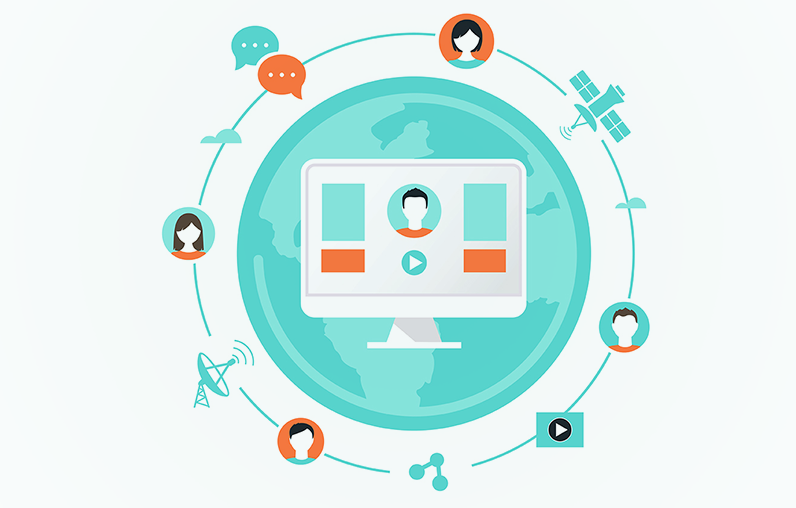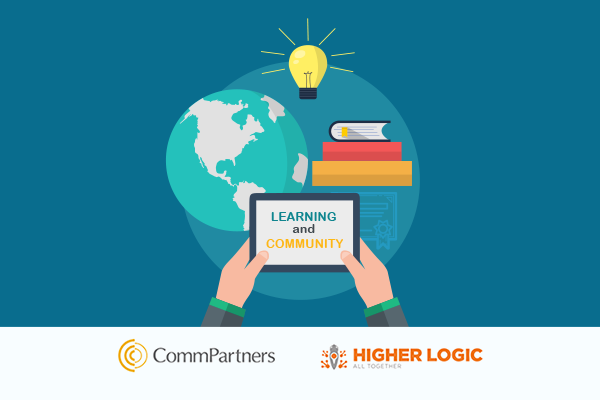
by Rich Finstein | Nov 13, 2017 | Blog
At the 2017 Higher Logic Super Forum, I along with an association colleague, facilitated a session on the virtues of developing an integrated approach for bringing together online community engagement and an LMS in a single offering. During the session, we discussed how associations typically have these areas configured as unique components. In reality, both provide opportunities for learning. Since an online community engagement strategy is usually focused on facilitating peer collaboration, and the learning management system (LMS) provides expert content, it’s natural they come together to support the stakeholder experience in a synergistic way.
A key connector in this relationship are live online events and webinars. Traditionally, live events and webinars have been positioned on their own through a registration and authentication page provided by the webinar vendor or a separate catalog of programs. A better, more engaging approach is to promote and provide access to these events within a private community.
Here are 5 considerations for using live, online events and webcasts to increase the impact of your online community engagement strategy:
- Registration will feel like a continuum of existing collaboration. Participants who have already been invested in the topic can now be encouraged, in an intuitive way, to take the step to register and participate in online discussions.
- Participation from new and non-engaged members is encouraged with an integrated approach. Live, online events and webinars are tangible ways to draw participants to specific areas of your Web presence. Offering them through a dedicated part of your LMS gives users a reason to create a profile and begin to participate in other social learning and online community engagement opportunities.
- Leverage interaction before and after an online event or webcast. Participants should be able to see who is attending, exchange ideas, and engage the presenters before the event. Afterward, users can continue any conversations that may have been cut short (which happens often!) during an hour program.
- Integrate results from live event and webinar attendance with other participation metrics, providing a complete picture of online community engagement. Host organizations will appreciate having a central repository to evaluate participation outcomes.
- Award badges or ribbons for participation or achievement from webinars in the same area where recognition is provided for other activities. Providing recognition will further encourage participation in future live, online events.
We see webinars and live events becoming much more collaborative and transparent. Bringing them into your online community is a natural way to build participation and provide synergy with your other educational objectives.
If you have interest in learning more about integrating events and webinars with your community contact us online, or email Meghan Gowen at mgowen@commpartners.com.

by Rich Finstein | Sep 25, 2017 | Blog
It has been almost a year since CommPartners and Higher Logic began formally collaborating with the premise that learning in its many forms is a natural extension of community engagement. This concept is not new for most of us. I remember many conversations that took place at ASAE Annual Conferences and other meetings over the years about the virtues of social learning. Everyone agreed that the notion of peer to peer, sharing of ideas should accompany and be integrated with knowledge shared by experts. After all, when we think of the best learning experiences, it’s typically a conference with our community peers. We value the sessions but a significant part of our reason for attending is the knowledge we receive from colleagues. So why is online learning experiences so segmented?
While in theory this sounded like a wise idea, the execution of social learning was slow to take hold. There are likely many reasons for this, but the lack of an online platform that truly enabled Web based social experiences was not helping to forge the way.
Last year, Higher Logic and CommPartners’ teams got together to identify how we could make community driven learning a reality. We had certain ideas and it took quite an investment of time to identify how this could work. Our first success was the creation of Higher Logic’s Online Academy courses. This training enables participants to sign up and participate in a self-paced training program (powered through our learning management system, Elevate LMS) within the community. Completion of courses is reported to Higher Logic’s activities area, giving the community member and the host organization, in this case Higher Logic, a more holistic report of engagement that was taking place.
After this initial success, our efforts turned towards helping associations realize the benefits of bridging their Learning Management System and community to offer their stakeholders an integrated experience. As the discussions evolved, one question became clear; why are we asking our participants to navigate to two separate and distinct areas of a website when both areas provide opportunities for learning? Shouldn’t the synergy between these two components be together? So we went to work and came up with a fully integrated platform both visually and programmatically.
Key elements of Higher Logic’s community and CommPartners Elevate Learning Management System now work together, prioritizing the participant experience. Twelve months later we have many organizations that have embraced this integrated approach and we have certainly learned a lot. Here are four key lessons learned from bridging these two areas:
1. In many cases organizations still need a strong, independent learning presence. In these cases we have integrated the two platforms on a micro level. Examples include pulling in community participants that are enrolled in a course or webinar or reporting learning results to the activities area in the community. These are steps that more subtly bring the two together.
2. It’s important to have staff from both your education and community teams involved. There are many variations of community driven learning that can take place. Getting initial buy-in will ensure a smooth process and better result.
3. Opportunities for social learning extend beyond typical webinars or training. A program such as a virtual conference hosted through the LMS has the power to be integrated with a conference community leveraging the engagement already in place.
4. Working together allows us to provide better guidance to our clients. It’s been extremely valuable for the Higher Logic and CommPartners teams to work closely together to bridge the knowledge gap and provide better ideas and insights to our clients.
We’re excited about continuing to bridge the gap between community and learning. If you have an interest in integrating peer to peer idea sharing with traditional learning contact a representative from either Higher Logic or CommPartners to learn more.
VIEW ON-DEMAND WEBINAR
Learning & Community: Together at Last – Register



